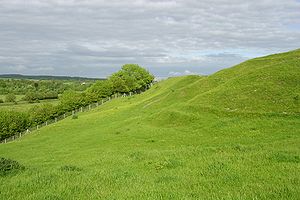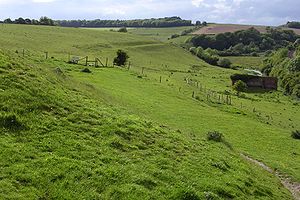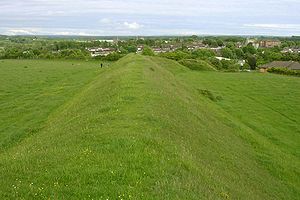
Poundbury Hill
Encyclopedia

Hill fort
A hill fort is a type of earthworks used as a fortified refuge or defended settlement, located to exploit a rise in elevation for defensive advantage. They are typically European and of the Bronze and Iron Ages. Some were used in the post-Roman period...
is the site of a Middle Bronze Age
Bronze Age
The Bronze Age is a period characterized by the use of copper and its alloy bronze as the chief hard materials in the manufacture of some implements and weapons. Chronologically, it stands between the Stone Age and Iron Age...
enclosure. It is roughly rectangular and it is likely that it was designed to command views over the River Frome
River Frome, Dorset
The River Frome is a river in Dorset in the south of England. At 30 miles long it is the major chalkstream in southwest England. It is navigable upstream from Poole Harbour as far as the town of Wareham.-Geography:...
and the Frome valley to the north. The main entrance to the fort is on the eastern end. It overlooks the county town
County town
A county town is a county's administrative centre in the United Kingdom or Ireland. County towns are usually the location of administrative or judicial functions, or established over time as the de facto main town of a county. The concept of a county town eventually became detached from its...
of Dorchester, Dorset, England
England
England is a country that is part of the United Kingdom. It shares land borders with Scotland to the north and Wales to the west; the Irish Sea is to the north west, the Celtic Sea to the south west, with the North Sea to the east and the English Channel to the south separating it from continental...
.
Excavation
It was first excavated in 1938. Details of the fort's serial development were discovered. In the 4th century BC, the banks were faced with timber and a deep V-shaped ditch was dug. The banks were enlarged and strengthened and a limestoneLimestone
Limestone is a sedimentary rock composed largely of the minerals calcite and aragonite, which are different crystal forms of calcium carbonate . Many limestones are composed from skeletal fragments of marine organisms such as coral or foraminifera....
revetment
Revetment
Revetments, or revêtements , have a variety of meanings in architecture, engineering and art history. In stream restoration, river engineering or coastal management, they are sloping structures placed on banks or cliffs in such a way as to absorb the energy of incoming water...
was added, in circa 50 BC.
Cemetery
Just outside the fort was a large Romano-BritishRomano-British
Romano-British culture describes the culture that arose in Britain under the Roman Empire following the Roman conquest of AD 43 and the creation of the province of Britannia. It arose as a fusion of the imported Roman culture with that of the indigenous Britons, a people of Celtic language and...
cemetery
Cemetery
A cemetery is a place in which dead bodies and cremated remains are buried. The term "cemetery" implies that the land is specifically designated as a burying ground. Cemeteries in the Western world are where the final ceremonies of death are observed...
, of the 4th century AD. The cemetery, located on the northeast side of the hill fort, was excavated during the 1970s.

Aqueduct
The northern and eastern sides of the hillfort's outer defences were damaged by the construction of the RomanAncient Rome
Ancient Rome was a thriving civilization that grew on the Italian Peninsula as early as the 8th century BC. Located along the Mediterranean Sea and centered on the city of Rome, it expanded to one of the largest empires in the ancient world....
aqueduct
Aqueduct
An aqueduct is a water supply or navigable channel constructed to convey water. In modern engineering, the term is used for any system of pipes, ditches, canals, tunnels, and other structures used for this purpose....
which supplied the settlement of Durnovaria
Durnovaria
Durnovaria is the Latin form of the Brythonic name for the Roman town of Dorchester in the modern English county of Dorset.-Romans at Maiden Castle:...
(Dorchester) with fresh water from a reservoir around 4.5 km (2.8 mi) away. The aqueduct terrace, situated on the northeast-facing slope of the Frome valley, has a very slight gradient (averaging 1:1750), achieved by a winding route almost 9 km (5.6 mi) long. This aqueduct (80 cm wide by 30 cm deep) was a small closed channel with clay bottom and wooden sides. It had a wooden cover with a protective covering of soil and grass, to prevent contamination of the water, which was brought from a dam and lake by what is now Littlewood Farm in Frampton
Frampton, Dorset
Frampton is a village in west Dorset, England, situated in the Frome valley three miles north west of Dorchester at . The village has a population of 456 , 6.9% of dwellings are second homes ....
. The water was later used for the new town of Dorchester and its public baths. The aqueduct was abandoned in about 160 AD
Anno Domini
and Before Christ are designations used to label or number years used with the Julian and Gregorian calendars....
, following the collapse of the reservoir dam in Frampton.
Railway line
The main Dorchester to YeovilYeovil
Yeovil is a town and civil parish in south Somerset, England. The parish had a population of 27,949 at the 2001 census, although the wider urban area had a population of 42,140...
railway line (now called the Heart of Wessex Line
Heart of Wessex Line
The Heart of Wessex Line, also known as the Bristol to Weymouth line, is a United Kingdom railway line that runs from Bristol to Westbury to Weymouth...
) was tunnelled beneath the hill fort, thereby minimising damage to the ramparts. Brunel
Isambard Kingdom Brunel
Isambard Kingdom Brunel, FRS , was a British civil engineer who built bridges and dockyards including the construction of the first major British railway, the Great Western Railway; a series of steamships, including the first propeller-driven transatlantic steamship; and numerous important bridges...
originally wanted to put the tracks in a cutting through the site, but local outrage at the plan meant that the more expensive tunnel
Tunnel
A tunnel is an underground passageway, completely enclosed except for openings for egress, commonly at each end.A tunnel may be for foot or vehicular road traffic, for rail traffic, or for a canal. Some tunnels are aqueducts to supply water for consumption or for hydroelectric stations or are sewers...
was chosen. The protest against the Poundbury cutting plan also led to the formation of the Dorset archaeological society.


